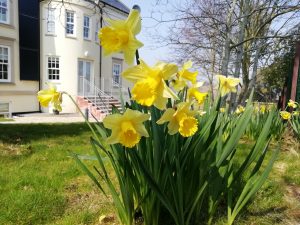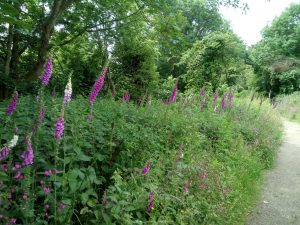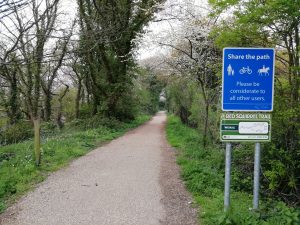There is plenty of wildlife to be seen all around Shanklin and further afield – and we’ve got some top tips on where to go and what to look out for!
Your Apartment’s Garden

All of our apartments benefit from gardens, which have a selection of trees. grassed areas and planting. You are likely to see a selection of birds in the garden – including the likes of jays, robins, gulls, sparrows and sparrowhawks seen in the gardens and around Shanklin. Each apartment has a set of binoculars, perfect for a bit of bird watching.
In addition, if you’re lucky, you may spot one of our native red squirrels. Keep your eyes peeled, as they are always a special sight and Wight Squirrel Project suggests that Shanklin’s Old Village and surrounding area is one of the top places to find them on the island.
Local Parks and Coastal Path To Sandown

Shanklin has a selection of parks, which are open to the public all day and all year round. Our main park is Big Mead in Church Road, which is a large open grassed park with duck pond and children’s play area. Look out for the daffodils during the spring in two large areas and the conkers in the autumn along the tree line next to the road and elsewhere. The park extends into Westhill, which is seen from Shanklin Manor, and features Shanklin Cricket Club.
We also have Tower Cottage in Chine Avenue, the gardens of an old thatched tea rooms that was destroyed in World War Two, which goes along the edge of Shanklin Chine and features grassland, plenty of trees and a route to the beach by Chine Hill and access to Keats Green and the cliff top coastal path to Sandown.
Along the top and bottom of the cliffs. you can see various plants including tree lupin, evening primrose, crocosmia, everlasting pea, horsetail fern, hemp agrimony and thistles, as well as butterflies including red admiral, large white, painted lady and clouded yellow and birds including kestrels, fulmar petrels, swifts and cormorants. For more, there is an information board along Keats Green.
On the other side of the chine is Rylstone Gardens in Popham Road, which again has grassland, trees and another route to the beach via Appley Steps. It also has a bandstand, which is frequently used throughout the summer months for performances from Shanklin Town Brass Bands and visiting bands (more here), as well as open air worship from Christians Working Together In Shanklin (more here), all subject to weather. It also has Rylstone Tea Gardens for a spot of lunch, its well presented gardens and a game of crazy golf.
Shanklin Chine
A real jewel for wildlife fans, Shanklin Chine is right in the heart of Shanklin’s Old Village. It offers an opportunity to see its famous waterfall and see the flora, fauna and animals that make it their home. You’ll also see 50 species of moss and liverworts, over 150 varieties of wild plants including ferns and grasses, wild garlic, horsetails, golden saxifrage, wild fuchsia, winter-flowering heliotrope and gunnera manicata, birds such as kestrels, blackbirds, robins, blue tits and grey wagtails, a wide selection of trees including elm, sycamore, alder, elder and beech, island bred chipmunks, butterflies and spiders, and a rescue aviary with cockatiels, Meyers parrots, Senegal parrots and Asian blue quails. There is a nature trail available to guide you through the chine and a nature hide.
Haddon’s Pits and The Landslip

On Luccombe Road, a short walk from Highlands and next door to The Priory is Haddon’s Pits, which is a National Trust site in the Isle of Wight Natural Landscape (previously Area of Outstanding Natural Beauty [AONB]). It was a former quarry and purchased using a bequest. With fantastic views across Shanklin and Sandown bay, the site and its surrounding area is home to whitethroad and long tailed tits, which breed in the scrub, swallows, house martins, ravens and peregrine falcons. The brambles, hawthorn and elderberry is a great shelter for birds and insects, but is maintained by cows and sheep during selected times during the year. The area is also available as a take off point for hang and paragliding – you can find out more on the Isle of Wight Hang Gliding and Paragliding Club’s website here.
Further up Luccombe Road and there is additional areas of National Trust land, then on to the coastal path through the landslip to Bonchurch and Ventnor. You’ll see plenty of trees such as beech, sycamore, hazel, ash, holm and English oak, wild flowers and birds such as greater spotted and green woodpecker, blackbirds, robins, treecreeper, goldcrest, sparrowhawks, kestrel and little owl along the paths. Common butterflies include green hairstreak, speckled wood, dingy skipper, common blue, holly blue and Glanville fritillary, which has had a new habitat built by Ventnor Town Council and Natural England on Bonchurch revetment. You can find out more on iwnhas.org. In the damp shady locations, there are plenty of ferns, especially at Devil’s Chimney, which has hart’s tongue fern. There are also views across the sea towards Ventnor and the well known wishing seat on the route also. You can find out more on the information boards at Smuggler’s Haven car park in Bonchurch and also Bonchurch pond.
If you want to walk the area, the National Trust has created a trail through the landslip and Ventnor which passes all of our properties, so pick up the trail at your apartment and follow the circular route. You can find the trail, including a printer friendly version, on nationaltrust.org.uk.
Red Squirrel Trail

A perfect location to experience the countryside of the Isle of Wight, the Red Squirrel Trail’s Sandown to Wroxall leg passes through Shanklin, much of which is on the dedicated cycle trail between Lower Hyde in Shanklin and Wroxall. Along this route, which is suitable for cyclists, walkers and horse riders, you’ll experience views across the fields, farms and landscape of Shanklin and Wroxall. You may well spot a fields of cows and horses, as well as meeting horses on the trail itself and spotting the likes of rabbits, pheasants and more birds in the fields surrounding the trail. You can download a map and get more information at redsquirreltrail.org.uk.
Nature Reserves And Woods
We are lucky to have a selection of nature reserves and woods in the area, which offer plenty of local wildlife.
Sibden Hill and Batts Copse off Denny Gardens and a short distance from the Red Squirrel Trail offer differing reserves, both maintained by Gift To Nature. Sibden Hill offers a grassland area with scrub, bracken, bramble and woodlands. Plants include hydrangea, gorse, hawthorn, blackthorn and rhododendron, wild flowers such as bluebell, sheep’s sorrel, greater stitchwort, rosebay willowherb, red campion, honeysuckle, foxglove and sheep’s sorrel, trees such as hazel, oak, sycamore, elm, ash, beech and silver birch and birds including blackcap, treecreeper, jay, goldcrest, siskin, linnet and mistle thrush.
At Batts Copse, there is a small brook running through the woodland with hart’s tongue, male fern, nettle, bramble and cleavers in the undergrowth. Plants include wood anemone, bluebell, ramsons, pendulous sedge and three cornered leek, trees such as hazel, oak, sycamore, wild cherry and silver birch, birds including redwing, greenfinch, bullfinch and song thrush and animals such as fox, bats, hedgehog, badger, red squirrel, grass snakes, slow worms, common frog and common toad. For more, you can see gifttonature.org.uk.
America Wood is located on Victoria Avenue and is a wood with a high oak forest and downy birch. Badgers can be found in the wood along with red squirrels. It is maintained by the Woodland Trust and you can find more on woodlandtrust.org.uk.
Further away, there is Copse Mead, which is next to Shanklin Cemetery on Cemetery Road, which is an unimproved wildflower meadow run by Wight Nature Fund. The habitat includes slow-worms, hedgehogs, wasp spiders, pipistrelle bats, long-winged conehead bush crickets, moths and butterflies, a selection of birds and wild plants such as wild daffodils, bluebells, cherry-plum blossom, wild flowers and grasses. You can find out more on wightnaturefund.org.uk.
Last Updated: 22/02/2024
